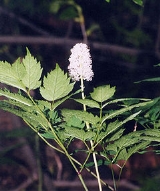
Actaea pachypoda
Encyclopedia
Actaea pachypoda is a flowering plant
in the family Ranunculaceae
, native to eastern North America
.
 It is a herbaceous
It is a herbaceous
perennial plant
growing to 50 cm or more tall (1½ to 2 feet tall and 3 feet wide). It has toothed, bipinnate compound leaves
up to 40 cm long and 30 cm broad. The white flower
s are produced in spring in a dense raceme
about 10 cm long. Its most striking feature is its fruit
, a 1 cm diameter white berry
, whose size, shape, and black stigma scar give the species its other common name, "doll's eyes". The berries ripen over the summer, turning into a fruit that persists on the plant until frost. Fall foliage color may be yellowish, and is fairly unremarkable.
White baneberry prefers clay
to coarse loam
y upland soils, and are found in hardwood
and mixed-forest stands. In cultivation it requires part to full shade, rich loamy soil, and regular water with good drainage to reproduce its native habitat.
The berries are highly poisonous, and the entire plant is considered poisonous to humans. The berries contain cardiogenic toxins which can have an immediate sedative effect on human cardiac muscle tissue, and are the most poisonous part of the plant. Ingestion of the berries can lead to cardiac arrest and death. The berries are harmless to birds, the plant's primary seed dispersers.
Flowering plant
The flowering plants , also known as Angiospermae or Magnoliophyta, are the most diverse group of land plants. Angiosperms are seed-producing plants like the gymnosperms and can be distinguished from the gymnosperms by a series of synapomorphies...
in the family Ranunculaceae
Ranunculaceae
Ranunculaceae are a family of about 1700 species of flowering plants in about 60 genera, distributed worldwide....
, native to eastern North America
North America
North America is a continent wholly within the Northern Hemisphere and almost wholly within the Western Hemisphere. It is also considered a northern subcontinent of the Americas...
.

Herbaceous
A herbaceous plant is a plant that has leaves and stems that die down at the end of the growing season to the soil level. They have no persistent woody stem above ground...
perennial plant
Perennial plant
A perennial plant or simply perennial is a plant that lives for more than two years. The term is often used to differentiate a plant from shorter lived annuals and biennials. The term is sometimes misused by commercial gardeners or horticulturalists to describe only herbaceous perennials...
growing to 50 cm or more tall (1½ to 2 feet tall and 3 feet wide). It has toothed, bipinnate compound leaves
Leaf
A leaf is an organ of a vascular plant, as defined in botanical terms, and in particular in plant morphology. Foliage is a mass noun that refers to leaves as a feature of plants....
up to 40 cm long and 30 cm broad. The white flower
Flower
A flower, sometimes known as a bloom or blossom, is the reproductive structure found in flowering plants . The biological function of a flower is to effect reproduction, usually by providing a mechanism for the union of sperm with eggs...
s are produced in spring in a dense raceme
Raceme
A raceme is a type of inflorescence that is unbranched and indeterminate and bears pedicellate flowers — flowers having short floral stalks called pedicels — along the axis. In botany, axis means a shoot, in this case one bearing the flowers. In a raceme, the oldest flowers are borne...
about 10 cm long. Its most striking feature is its fruit
Fruit
In broad terms, a fruit is a structure of a plant that contains its seeds.The term has different meanings dependent on context. In non-technical usage, such as food preparation, fruit normally means the fleshy seed-associated structures of certain plants that are sweet and edible in the raw state,...
, a 1 cm diameter white berry
Berry
The botanical definition of a berry is a fleshy fruit produced from a single ovary. Grapes are an example. The berry is the most common type of fleshy fruit in which the entire ovary wall ripens into an edible pericarp. They may have one or more carpels with a thin covering and fleshy interiors....
, whose size, shape, and black stigma scar give the species its other common name, "doll's eyes". The berries ripen over the summer, turning into a fruit that persists on the plant until frost. Fall foliage color may be yellowish, and is fairly unremarkable.
White baneberry prefers clay
Clay
Clay is a general term including many combinations of one or more clay minerals with traces of metal oxides and organic matter. Geologic clay deposits are mostly composed of phyllosilicate minerals containing variable amounts of water trapped in the mineral structure.- Formation :Clay minerals...
to coarse loam
Loam
Loam is soil composed of sand, silt, and clay in relatively even concentration . Loam soils generally contain more nutrients and humus than sandy soils, have better infiltration and drainage than silty soils, and are easier to till than clay soils...
y upland soils, and are found in hardwood
Hardwood
Hardwood is wood from angiosperm trees . It may also be used for those trees themselves: these are usually broad-leaved; in temperate and boreal latitudes they are mostly deciduous, but in tropics and subtropics mostly evergreen.Hardwood contrasts with softwood...
and mixed-forest stands. In cultivation it requires part to full shade, rich loamy soil, and regular water with good drainage to reproduce its native habitat.
The berries are highly poisonous, and the entire plant is considered poisonous to humans. The berries contain cardiogenic toxins which can have an immediate sedative effect on human cardiac muscle tissue, and are the most poisonous part of the plant. Ingestion of the berries can lead to cardiac arrest and death. The berries are harmless to birds, the plant's primary seed dispersers.

